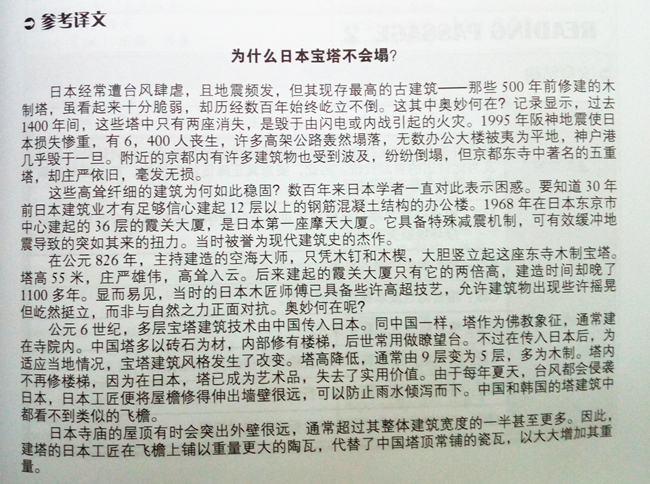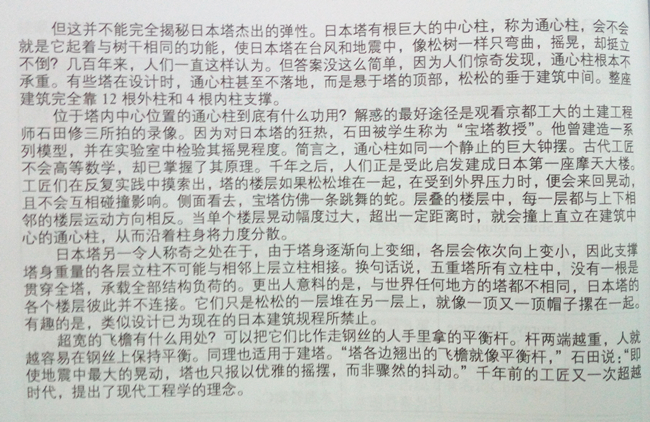2017-04-20 22:01来源:互联网作者:上海管理员
摘要:剑7test2雅思阅读passage1原文+翻译:Why pagodas don’t fall down 为什么日本宝塔不会塌
剑7test2雅思阅读passage1原文+翻译:为什么日本宝塔不会塌
相关的解析,请: 剑桥雅思7阅读+答案解析test2passage1

 、
、
以下是该篇原文:剑7test2雅思阅读passage1原文+翻译:Why pagodas don’t fall down
Why pagodas don’t fall down
In a land swept by typhoons and shaken by earthquakes, how have Japan's tallest and seemingly flimsiest old buildings - 500 or so wooden pagodas - remained standing for centuries? Records show that only two have collapsed during the past 1400 years. Those that have disappeared were destroyed by fire as a result of lightning or civil war. The disastrous Hanshin earthquake in 1995 killed 6,400 people, toppled elevated highways, flattened office blocks and devastated the port area of Kobe. Yet it left the magnificent five-storey pagoda at the Toji temple in nearby Kyoto unscathed, though it levelled a number of buildings in the neighbourhood.
Japanese scholars have been mystified for ages about why these tall, slender buildings are so stable. It was only thirty years ago that the building industry felt confident enough to erect office blocks of steel and reinforced concrete that had more than a dozen floors. With its special shock absorbers to dampen the effect of sudden sideways movements from an earthquake, the thirty-six-storey Kasumigaseki building in central Tokyo - Japan's first skyscraper - was considered a masterpiece of modern engineering when it was built in 1968.
Yet in 826, with only pegs and wedges to keep his wooden structure upright, the master builder Kobodaishi had no hesitation in sending his majestic Toji pagoda soaring fifty-five metres into the sky - nearly half as high as the Kasumigaseki skyscraper built some eleven centuries later. Clearly, Japanese carpenters of the day knew a few tricks about allowing a building to sway and settle itself rather than fight nature's forces. But what sort of tricks?
The multi-storey pagoda came to Japan from China in the sixth century. As in China, they were first introduced with Buddhism and were attached to important temples. The Chinese built their pagodas in brick or stone, with inner staircases, and used them in later centuries mainly as watchtowers. When the pagoda reached Japan, however, its architecture was freely adapted to local conditions - they were built less high, typically five rather than nine storeys, made mainly of wood and the staircase was dispensed with because the Japanese pagoda did not have any practical use but became more of an art object. Because of the typhoons that batter Japan in the summer, Japanese builders learned to extend the eaves of buildings further beyond the walls. This prevents rainwater gushing down the walls. Pagodas in China and Korea have nothing like the overhang that is found on pagodas in Japan.
The roof of a Japanese temple building can be made to overhang the sides of the structure by fifty per cent or more of the building's overall width. For the same reason, the builders of Japanese pagodas seem to have further increased their weight by choosing to cover these extended eaves not with the porcelain tiles of many Chinese pagodas but with much heavier earthenware tiles.
But this does not totally explain the great resilience of Japanese pagodas. Is the answer that, like a tall pine tree, the Japanese pagoda - with its massive trunk-like central pillar known as shinbashira - simply flexes and sways during a typhoon or earthquake? For centuries, many thought so. But the answer is not so simple because the startling thing is that the shinbashira actually carries no load at all. In fact, in some pagoda designs, it does not even rest on the ground, but is suspended from the top of the pagoda - hanging loosely down through the middle of the building. The weight of the building is supported entirely by twelve outer and four inner columns.
And what is the role of the shinbashira, the central pillar? The best way to understand the shinbashira's role is to watch a video made by Shuzo Ishida, a structural engineer at Kyoto Institute of Technology. Mr Ishida, known to his students as 'Professor Pagoda' because of his passion to understand the pagoda, has built a series of models and tested them on a 'shake- table' in his laboratory. In short, the shinbashira was acting like an enormous stationary pendulum. The ancient craftsmen, apparently without the assistance of very advanced mathematics, seemed to grasp the principles that were, more than a thousand years later, applied in the construction of Japan's first skyscraper. What those early craftsmen had found by trial and error was that under pressure a pagoda's loose stack of floors could be made to slither to and fro independent of one another. Viewed from the side, the pagoda seemed to be doing a snake dance - with each consecutive floor moving in the opposite direction to its neighbours above and below. The shinbashira, running up through a hole in the centre of the building, constrained individual storeys from moving too far because, after moving a certain distance, they banged into it, transmitting energy away along the column.
Another strange feature of the Japanese pagoda is that, because the building tapers, with each successive floor plan being smaller than the one below, none of the vertical pillars that carry the weight of the building is connected to its corresponding pillar above. In other words, a five- storey pagoda contains not even one pillar that travels right up through the building to carry the structural loads from the top to the bottom. More surprising is the fact that the individual storeys of a Japanese pagoda, unlike their counterparts elsewhere, are not actually connected to each other. They are simply stacked one on top of another like a pile of hats. Interestingly, such a design would not be permitted under current Japanese building regulations.
And the extra-wide eaves? Think of them as a tightrope walker's balancing pole. The bigger the mass at each end of the pole, the easier it is for the tightrope walker to maintain his or her balance. The same holds true for a pagoda. 'With the eaves extending out on all sides like balancing poles,' says Mr Ishida, 'the building responds to even the most powerful jolt of an earthquake with a graceful swaying, never an abrupt shaking.' Here again, Japanese master builders of a thousand years ago anticipated concepts of modern structural engineering.
上海新航道雅思培训班 ,一个盛产高分的摇篮,想和他们一起并肩成为学霸,赶紧加入我们吧!
免费领取最新剑桥雅思、TPO、SAT真题、百人留学备考群,名师答疑,助教监督,分享最新资讯,领取独家资料。
方法1:扫码添加新航道老师

微信号:shnc_2018
方法2:留下表单信息,老师会及时与您联系
| 课程名称 | 班级人数 | 课时 | 学费 | 报名 |
|---|---|---|---|---|
| 雅思预备课程6-10人 | 6-10人 | 80 | ¥13800 | 在线咨询 |
| 雅思入门段6-10人班 | 6-10人 | 80课时 | ¥18800 | 在线咨询 |
| 雅思强化段 6-10人班 | 6-10人 | 72课时 | ¥26800 | 在线咨询 |
| 雅思全程段 6-10人班 | 6-10人 | 192课时 | ¥45800 | 在线咨询 |
| 雅思精讲段6-10人班 | 6-10人 | 96课时 | ¥25800 | 在线咨询 |
| 课程名称 | 班级人数 | 课时 | 学费 | 报名 |
|---|---|---|---|---|
| 雅思强化段 20-30人班 | 20-30人 | 96课时 | ¥8800 | 在线咨询 |
| 雅思精讲段20-30人班 | 20-30人 | 96课时 | ¥7800 | 在线咨询 |
| 雅思全程段 20-30人班 | 20-30人 | 192课时 | ¥13800 | 在线咨询 |
| 课程名称 | 班级人数 | 课时 | 学费 | 报名 |
|---|---|---|---|---|
| 雅思预备课程6-10人 | 6-10人 | 126 | ¥15800 | 在线咨询 |
| 雅思强化段 6-10人班住宿班 | 6-10人 | 152 | ¥28800 | 在线咨询 |
| 雅思全程班 6-10人班住宿班 | 6-10人 | 304课时 | ¥50800 | 在线咨询 |
| 雅思精讲段 6-10人班住宿班 | 6-10人 | 152课时 | ¥29800 | 在线咨询 |
| 雅思入门段 6-10人班住宿班 | 6-10人 | 80课时 | ¥20800 | 在线咨询 |
| 课程名称 | 班级人数 | 课时 | 学费 | 报名 |
|---|---|---|---|---|
| 雅思强化段 20-30人班住宿班 | 20-30人 | 96课时 | ¥8800 | 在线咨询 |
| 雅思全程段 20-30人班住宿 | 20-30人 | 192课时 | ¥15800 | 在线咨询 |
| 雅思精讲段 20-30人班住宿班 | 20-30人 | 96课时 | ¥9800 | 在线咨询 |
| 课程名称 | 班级人数 | 课时 | 学费 | 报名 |
|---|---|---|---|---|
| 雅思一对一 | 1人 | 按需定制 | ¥980元 | 在线咨询 |
| 雅思托福预备班 | 6-10人 | 50 | ¥9800 | 在线咨询 |
| 雅思免费试听课 | 不限 | ¥0元 | 在线咨询 | |
| 雅思口语5月新题刷题实战营 | ¥999 | 在线咨询 |
热门搜索: 上海雅思培训 上海雅思培训机构哪家好 上海雅思封闭班 上海雅思1对1培训 上海雅思培训
免责声明
1、如转载本网原创文章,请表明出处;
2、本网转载媒体稿件旨在传播更多有益信息,并不代表同意该观点,本网不承担稿件侵权行为的连带责任;
3、如本网转载稿、资料分享涉及版权等问题,请作者见稿后速与新航道联系(电话:021-64380066),我们会第一时间删除。
地址:徐汇区文定路209号宝地文定商务中心1楼
乘车路线:地铁1/4号线上海体育馆、3/9号线宜山路站、11号线上海游泳馆站
总部地址:北京市海淀区中关村大街28-1号6层601 集团客服电话:400-097-9266 总部:北京新航道教育文化发展有限责任公司
Copyright © www.xhd.cn All Rights Reserved 京ICP备05069206


 微信公众号
微信公众号
 微信社群
微信社群